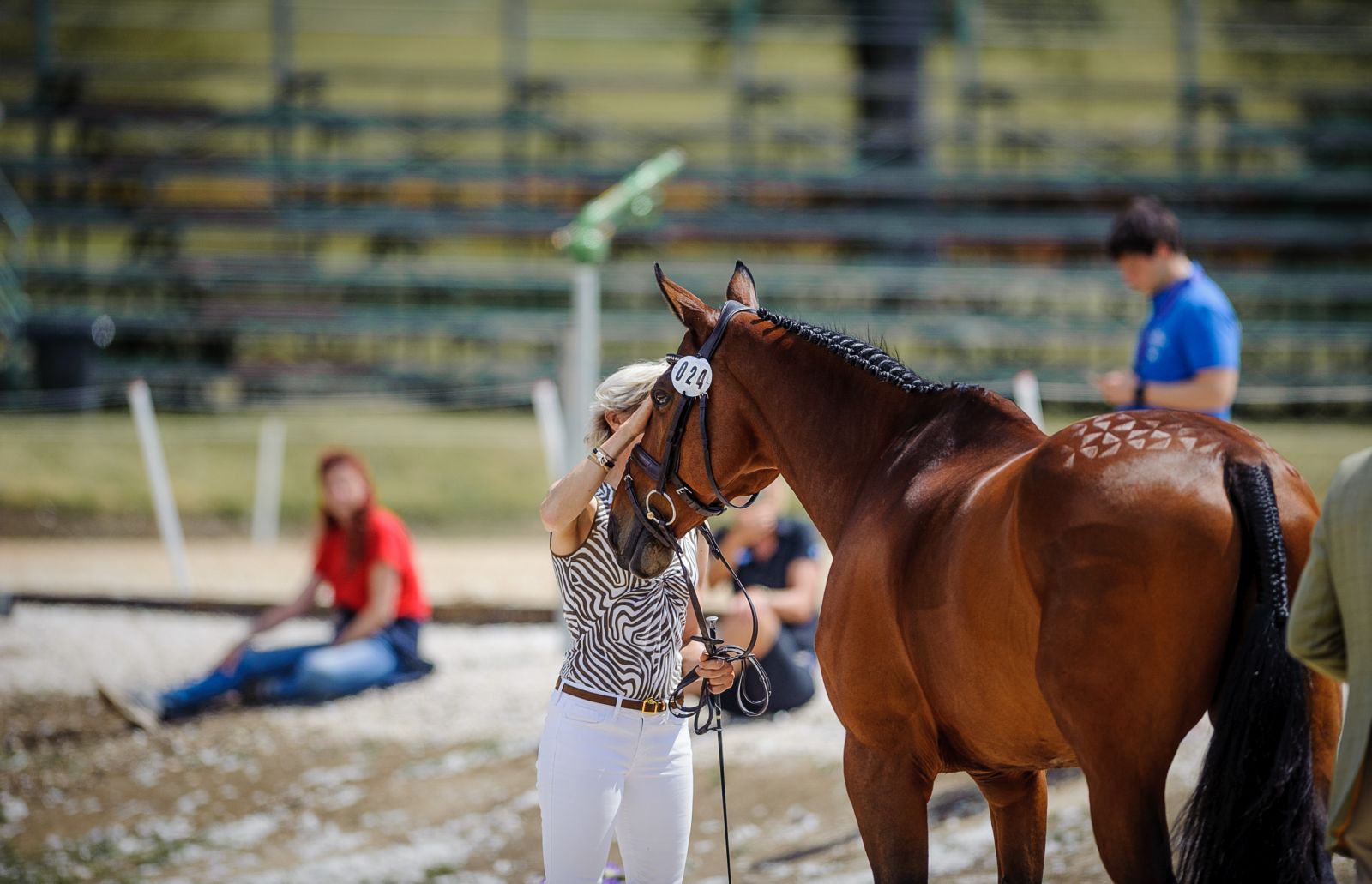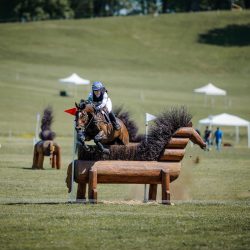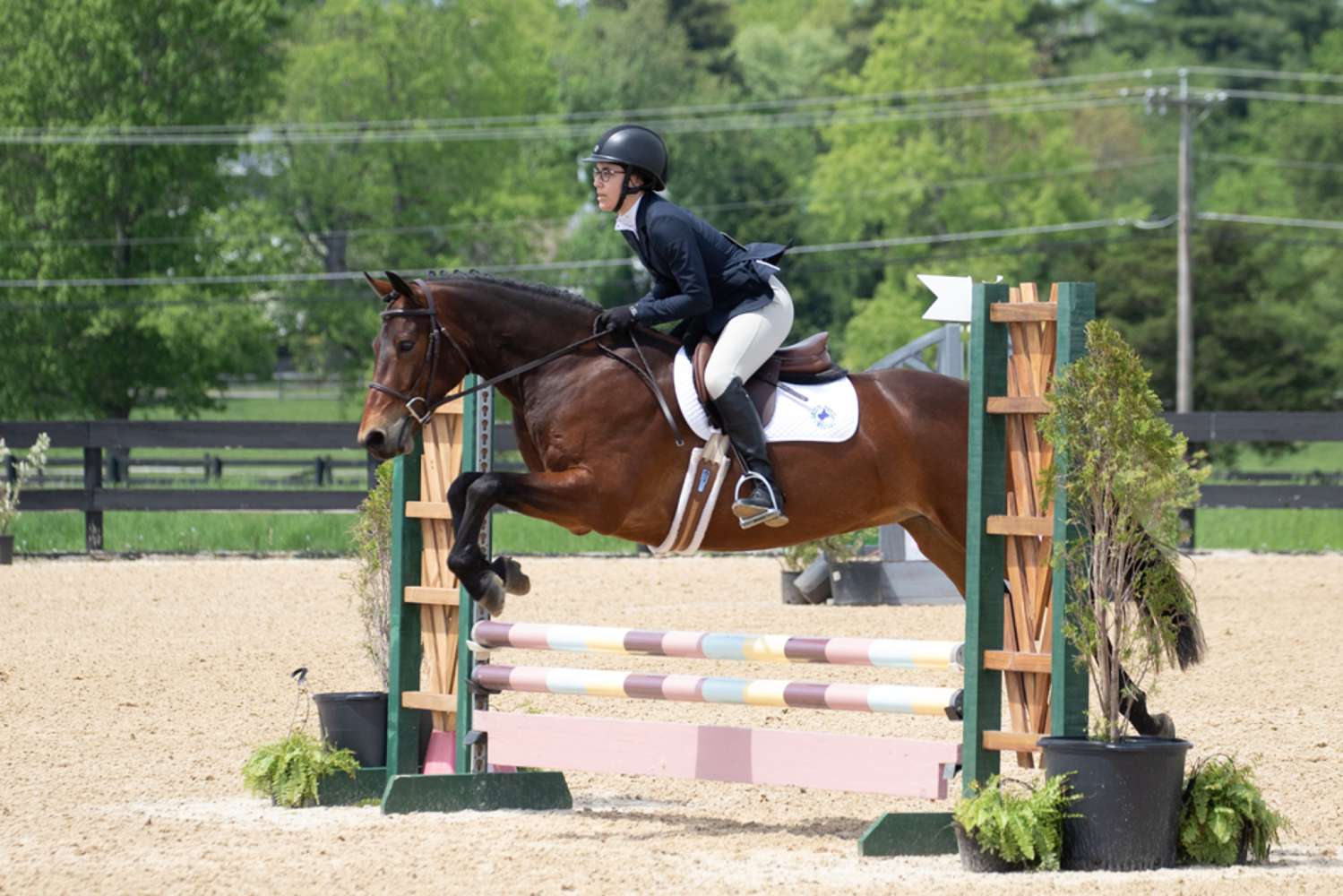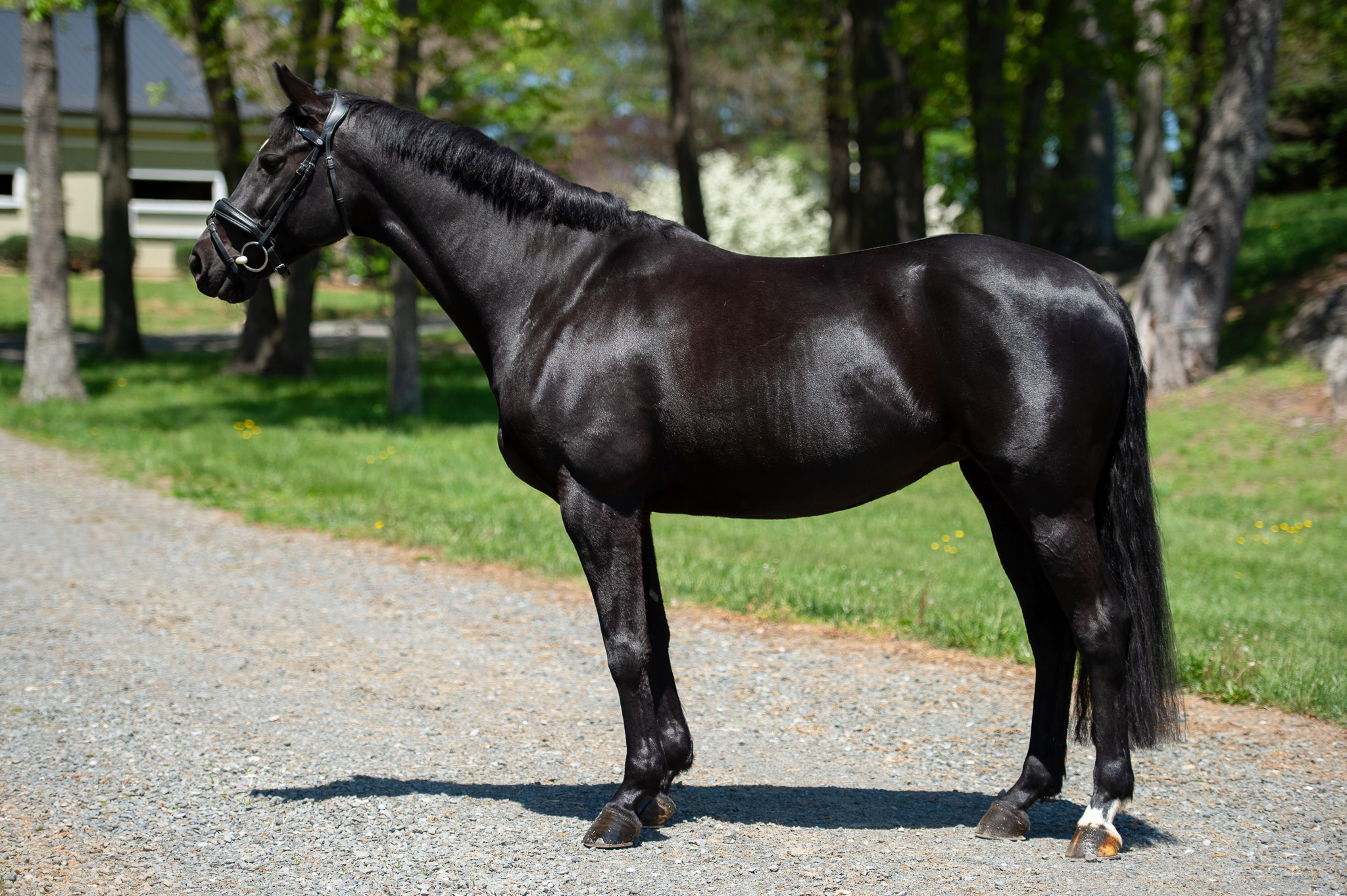
Italy’s Pietro Grandis jumps the single oxer at 9 with Scuderia 1918 Future. Photo by Tilly Berendt.
While this week’s CCIO4*-S at Italy’s Pratoni del Vivaro is an important competition in its own right as an early leg of 2022’s FEI Nations Cup series (and, not insignificantly, the Italian National Championships), many of those on the ground are on site with another mission in mind: to suss out the venue, and its unique challenges and assetts, ahead of this September’s World Eventing Championships. That’s certainly been our modus operandi this week, and though today’s 6:14 cross-country challenge was rather a different story to the circa-10 minute track we can expect to see in September, it gave us a great insight into course designer Giuseppe della Chiesa‘s philosophies, what we can expect from his championship track, and the kind of horse who might excel over such a course.

Being able to balance the gallop, and moderate energy use, down hills is crucial for an economic round at Pratoni. Emiliano Portale heads down to fence 8 with Aracne della’Esercita Italiano. Photo by Tilly Berendt.

After popping fence 8, the downhill slope continues…

…and once again, Emiliano demonstrates an excellent gallop for negotiating the question asked by the terrain here.
The first, and most significant, takeaway here is that Pratoni has terrain that’s not really comparable to any other major event. Its rolling hills provide almost constant undulations, with both long pulls uphill and testing downhill runs alongside small mounds and dips that offer interesting opportunities to maximise the challenge of a question through clever fence placement. And certainly, Guiseppe has been clever: the coffin complex at 10 and 11ABC featured a dip down to the ditch and a rise up out of it, which rode well through today but was generously spaced. Likewise, the water complex had a number of mounds and declines that mean that set stride patterns become irrelevant, and riders have to ride what’s underneath them, whether it’s a bounding leap down a slope or a shuffling, conservative step.
But while he’s maximised the terrain, he’s also been thoughtful about its effect on horses, and from fence 22 to the final jump at 28, every question was set on flat ground. They still exerted influence: his used of angled brushes at the penultimate fence saw a few glance out to the side, as did the corner-to-skinny table line at 23 and 24, but the overall effect wasn’t one that looked to punish a horse who’d begun to fatigue.
The ground absolutely helps in this effort. Pratoni was, many eons ago, a volcanic area, and so the footing feels almost custom-made for eventing: it’s a mix of volcanic sand and ash, and while it looks hard and dry on screen because of the dust it kicks up, it’s actually rather peat-y underfoot, which makes for quick going that tends to be fairly easy on horses.
Pratoni, which has been the host of eventing at the 1960 Olympics, the 1995 and 2007 European Championships, and the 1998 World Equestrian Games, isn’t actually an enormous venue, as you can see from the aerial view on the course map:

The course map for this week’s test event cross-country.
At 3350 meters, this week’s short-format track already uses up a fair amount of the available land, but Giuseppe has some interesting areas available for development ahead of the World Championships, which is set at a minimum distance of 5600m up to a maximum 5800m — shorter still than most CCI4*-L courses, but built at a technicality and dimensions that sit somewhere between four- and five-star. At the back end of the course, shown on the top right of the map, there’s plenty of room to add an extra loop utilising further, reasonably flat ground behind the water complex, and we’ll also see the inclusion of the ‘Pratoni slide’, a steep, ramped downhill slope that is situated just left of where the start box was today. The slide has been used regularly throughout Pratoni’s rich history, and its inclusion in this September’s World Championships opens up another loop of useful ground to play with early on in the course.
Though the courses will differ in length and, no doubt, technical difficulty, it’s still a useful exercise to analyse how today’s track worked, because it served as a chance for Giuseppe to see what works as much as it was a chance for national federations and riders to get a sense of the venue. We saw 63 starters leave the box, with 37 producing clear rounds — a 58.7% clear rate. 13 didn’t complete the course, giving us a 79.3% completion rate, suggesting that the influence was much more heavily weighted towards run-outs than falls. Seven partnerships delivered clear rounds inside the optimum time of 6:14 (and five of those were Swiss, in a real coup for Switzerland’s cross-country coach, Andrew Nicholson), and many of the penalties picked up on course were well spread among the combinations.
One question did exert considerable influence: the first combination, a double of brushes at the top of a hill and under cover of the trees at 7ABC caused 15 refusals, 13 of which came as horses skimmed by the second element, two rider falls, and two subsequent retirements. This came after six straightforward ‘flyer’ fences, most of which were on an uphill pull, and though the skinny wishing well on a turn up the hill at 6 walked as though it might require some significant set-up, which would likely have helped the navigation through the tricky combination, it actually largely rode very similarly to the simple fences before it.

The influential first combination at 7AB.
After an uphill pull to 7ABC, there was a downhill run to a sizeable rolltop at 8, which saw just one refusal through the day and tested riders’ ability to rebalance the stride length after having opened it up the hills and adjusted for the combination. The coffin complex at 10 and 11AB, which consisted of an upright rail at 10, a sharp slope down to the small ditch at 11A, and an uphill run to the wedge at 11B rode very well through the day, with just one rider fall and a refusal at the ditch. This was the first time we saw Giuseppe ask riders to ride the stride pattern that they found on landing, a question we saw return in the clever undulations at the water complex, in which horses might shuffle or bound down declines, nullifying any strict adherence to riding a certain number of strides. The emphasis, instead, became commitment to the line and to riding the rhythm as it presented itself, supporting the horse as needed to give them the balance and the power to clear each element.

Tim Price and Falco jump fence 14AB, a skinny in the water complex’s first loop. Photo by Tilly Berendt.
The first loop through the water complex caused a small handful of issues: no horses faulted at 13, a rolltop on dry land, and just one glanced off the skinny in the water at 14AB, while four horses ran into problems at 14C, a wide brush corner in the water, and one was deemed to have missed a flag here. None, though, picked up penalties in the second loop through the water, which asked them to run downhill to a rolltop on dry land, travel down a short, steep slope into the water, splash through and then jump a skinny on an island within the complex.

When fences are followed by a sudden dip or rise in terrain on the approach to the next element, some horses will bound through the line, as Mélody Johner’s Toubleu du Rueire demonstrates at the second loop through the water…

…while others tackle it in a shorter, more conservative stride pattern, like Sara Algotsson-Ostholt’s Chicuelo. Photos by Tilly Berendt.
After that, very little went awry on course: two horses picked up penalties at the capacious open ditch at 15, one faulted at 26, the second of two open oxers on a related distance, and one ran out at 27A, the first of two angled brush fences at the final combination.
“I think the horses that people trusted to see out the distance went out of the start box good and sharp, and they didn’t waste time — and then they could just about hold it and get home inside the time,” says Irish Olympian Sam Watson, who was one of several riders to attend the event unmounted. “You probably had to be really working and chasing it a bit in the middle, where it was a little bit more intense, but that’s partly due to the short format; the obstacles per meter are not going to be as intense over a long-format track. But I think Giuseppe will design it similarly: he’ll give you a bit of a run to get going, and a bit of a run to get home, but it’ll probably be quite intense in the middle again like this course. What it did show is that if you had a horse that set off a little bit slowly, they were only going to lose time in the middle. That was good to see, because we want the cross-country to be impactful.”

Spain’s Antonio Cejudo Caro pops the first element of the coffin complex with Duque HSM…

…the ditch at 11AB…

…and the skinny element at 11C. Photos by Tilly Berendt.
Though the influence of the first combination was attributed to a number of factors — interplay of light and shadow, and perceived lack of a preparatory fence among them — Sam’s estimation of the course as a whole is that it was roundly a success.
“His first combination did catch people. I think he showed with his spreading of the penalties and his ability to catch out a couple of the decent [horse and rider] combinations that he’s a clever course designer. He’s thinking about what he’s doing, and he knows where to place a fence, and yet I think what’s important for a championship is that it looked nice and it flowed well. They travelled well on the ground — you can see the volcanic dust kicking up off it, which means that there’s just a bit of give going on there. The horses like travelling on it.”
The bulk of the course’s intensity came from the first combination at 7ABC down to the corner to table question at 23 and 24: in the section of course between those two points, there were plenty of hills and undulations to deal with, plus the coffin complex, two loops through the water, single questions cleverly situated on cambers or rolling ground that required a change in approach, and a large semicircle that encompassed the open ditch, a big stick pile, and an airy trakehner before another pull up hill. As a result, many riders looked to second guess their ride through the second of the water questions, in which they tackled that sharp downhill slope.
“The last water was such a nice fence in that you’re saying ‘roll on’ — but the amount of people who went to their hand a little bit makes you wonder if, having gone through the intense bit and the rollercoaster of the first water and then coming back up the hill, the horse just needs a bit of reassurance,” Sam says. “Those are the things that you always have to have such an open mind about when you’re riding a course — you need to keep your instincts sharp. There’ll be fences you’re prepared to sit up for, but when you’re riding that piece of ground, you know that the horse has seen it early, he knows where he’s going and what he’s being asked to do, and you don’t need to take back — you can keep on coming. He’s in a good balance and he’s seen it, whereas at other fences you might think you need to keep them together a little bit more.”

Maxime Livio and Api du Libaire navigate the steady pull up to fence 18. Photo by Tilly Berendt.
Today’s ratio of time-catchers — seven of the 63 starters, or 11.1% — is probably a strong indicator of what we can expect come September, by Sam’s reckoning: “When going to ten minutes, the intensity reduces — which does make it easier to get the time. But he’s going to throw in a significant hill, and then you’ll have the fitness aspect. You’d hope that championship horses aren’t going to get tired over good ground at ten minutes; the top horses shouldn’t. I think the time we’ve seen today will be quite reflective of what we see on the day, and that’s not dissimilar to Tokyo: it’s very gettable, but a couple of the French combinations picked up a few seconds, and a couple of the Kiwis, and while they weren’t maybe going all out, they weren’t hanging about either. It hangs on the edge — ‘super easy’ or ‘super gettable’ isn’t a fair assessment, but I do think it’ll be the type of championships in which we’ll see ten or slightly more will be getting the time. Some people only want to see two or three, but the problem with designing for that is that you’ll see horses struggling to get home.”
Overall, there was a positive overall feeling about the day’s sport, and Sam agrees: “I still think Giuseppe’s kept a few things up his sleeve, but I don’t think he’ll have seen anything today that’ll make him think ‘I was too easy’, or ‘I was too tough’. I think he’s got it spot-on, and I think he’ll feel like he’s done a good day’s work today.”
-

-
A glimpse at Pratoni’s rolling hills.
-

-
Fence one.
-

-
Fence two.
-

-
Fence three.
-

-
Fence four.
-

-
Fence five begins to incorporate terrain, and is cleverly placed on a camber.
-

-
Fence six, a skinny wishing well on a turn up the first significant hill, had the potential to slow riders down to some 450mpm, but ultimately many took it in their stride en route to the first combination.
-

-
The first combination, a double of brush corners, proved the most influential of the day.
-

-
Fence eight, a single rolltop, is situated on a long downhill run, and required a balanced approach.
-

-
Fence nine’s timber oxer under a tree caused no issues.
-

-
Fence 10 is the first part of a separately numbered coffin complex…
-

-
…while 11AB is the ditch, and 11C, the skinny.
-

-
Riders have the choice between the left- or right-handed rails atop the hill at 12.
-

-
The first run through the water is a three-parter: there’s a rolltop at 13, followed by a skinny to a brush corner in the water at 14ABC.
-

-
The first part of the sweeping left-handed semicircle is a wide open ditch at 15.
-

-
Then, they jump a decent oxer at 16.
-

-
The complete the left-handed loop by popping an airy trakehner at 17.
-

-
After the trakehner, there’s a decent pull uphill to a set of rails under a pagoda at the apex of a hill at fence 18.
-

-
The final loop through the water complex brings riders in on a downhill approach to a rolltop at 19A…
-

-
…after which they coast down a slope into the water and up and out over a skinny on the mound.
-

-
A single fence at 20 has a forgiving profile.
-

-
Fence 21 has a downhill landing, and is the final terrain question.
-

-
Another single fence beckons at 22, bringing horses and riders onto the flat final section of the course.
-

-
23, a corner, and 24, the left-handed skinny table in the background, offer an accuracy question on flat ground.
-

-
Fences 25 and 26 are set on a related distance and, like many other questions on course, offered a flowing long route for those who felt their horses had tired.
-

-
The penultimate question, and final combination, at 27ABC.
-

-
The final fence — a beefy rolltop that isn’t usually covered with Austrian riders.
Pratoni 2022 Test Event: Website, Live Scoring, Live Stream, Entries, EN’s Coverage, EN’s Twitter, EN’s Instagram



















































































































































































